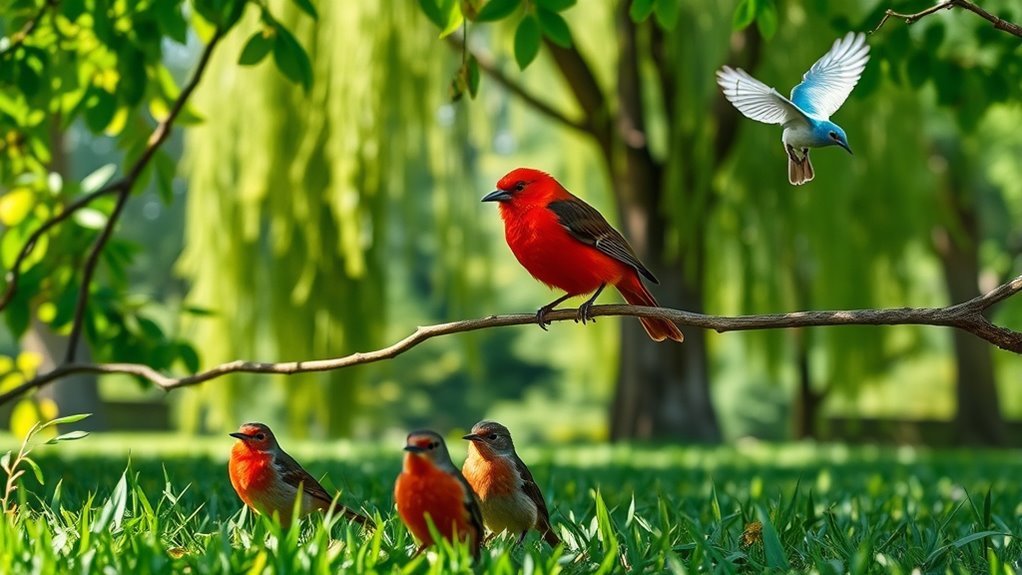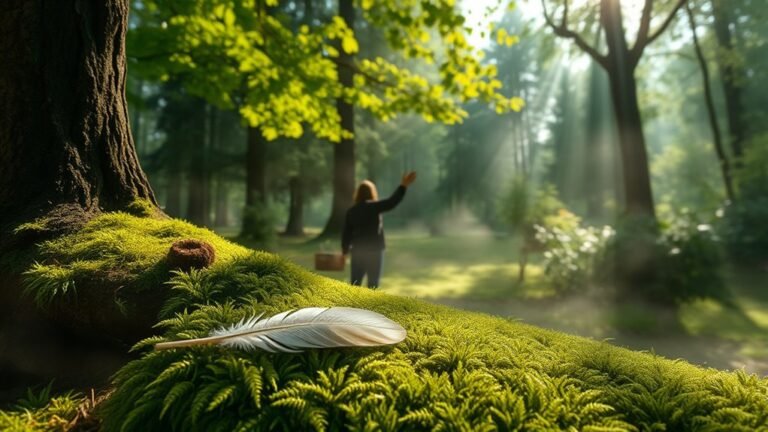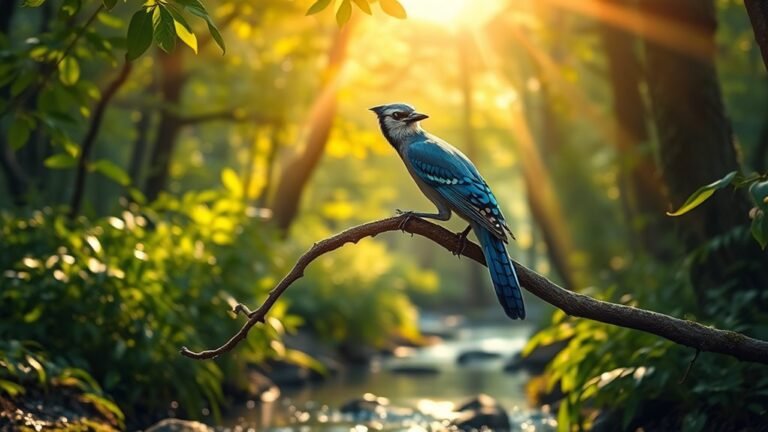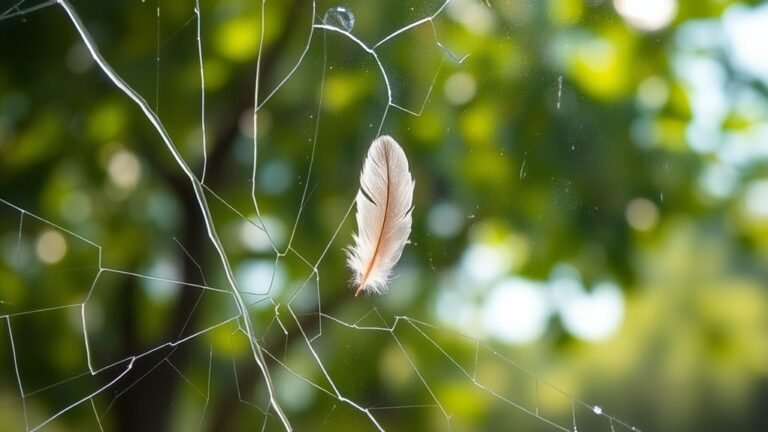10 Birds to Spot in Central Park, NY
Central Park is a great place to see many types of birds. You can spot the colorful American Robin that signals the arrival of spring. The Eastern Bluebird shows off its bright blue feathers. You might also see the friendly Black-capped Chickadee and the bold Northern Cardinal. Observing these birds adds enjoyment to your time in this park. What other bird species can you find in Central Park?
Key Takeaways
- The American Robin is easily spotted in Central Park with its bright orange-red breast, marking the arrival of spring.
- Look out for the Eastern Bluebird, recognized by its vibrant blue feathers and cheerful song in open fields.
- The Black-capped Chickadee, known for its friendly behavior and distinctive call, is frequently seen flitting among trees.
- The Northern Cardinal stands out with its striking red plumage and is often found in dense bushes, especially in pairs.
- The Common Yellowthroat may be secretive in wetlands, but its cheerful songs make it identifiable during spring migrations.
American Robin

When you walk through Central Park, you'll likely see the American Robin, a clear sign of spring. This bird has a bright orange-red breast that stands out.
You can often see robins searching for worms and insects on the ground, using their sharp eyesight.
American Robins migrate thousands of miles each year. They leave their winter homes to return to places like Central Park every spring.
This journey shows their strength and ability to adapt. Spotting a robin connects you to nature and reminds you of the cycles in wildlife, helping you appreciate the beauty of spring.
Eastern Bluebird
The Eastern Bluebird is a beautiful bird found in Central Park. It has bright blue feathers and a warm rust-colored chest. These birds like open fields and sparse woodlands, making park meadows perfect places for them to live.
You can often see them perched on branches or fences, looking for insects and berries. In spring and summer, Eastern Bluebirds are very active and can be seen chasing insects. Their songs are pleasant and create a calm atmosphere.
Look for nesting pairs in tree cavities or man-made boxes. They're caring parents, raising their young with great attention. Watching these birds allows you to connect with nature and enjoy the variety of birdlife in Central Park.
Black-capped Chickadee

Spotting a Black-capped Chickadee in Central Park brings joy to birdwatchers. These birds have black-capped heads and make a cheerful "chick-a-dee-dee-dee" call.
They eat seeds, insects, and suet, foraging in trees and on the ground. In winter, they often form flocks, allowing you to observe their active behavior.
You may see them flying from branch to branch or playing with each other. Their curious nature makes them friendly and approachable.
Include the Black-capped Chickadee on your Central Park birdwatching list for an enjoyable experience!
Northern Cardinal
Northern Cardinals are easy to spot in Central Park. Their bright red feathers and black mask make them visually striking. Birdwatchers enjoy their unique looks and beautiful songs.
They're known to be bold and often move in pairs, especially during breeding season. To see them at their best, visit in the early morning or late afternoon when they're most active.
Look for them in thick bushes or at bird feeders, as they're curious and like to explore. Spotting a male cardinal against greenery is especially rewarding.
Once you recognize their calls, identifying Northern Cardinals becomes an enjoyable way to connect with nature and the community of the park.
Common Yellowthroat

In Central Park, look for the Common Yellowthroat. This small warbler has bright yellow underparts and a distinct black mask. It prefers wetland areas like marshes and thickets, which offer good hiding spots for finding food.
During migration, these birds travel south in the fall and return north in the spring to breed. Spotting a Yellowthroat can be difficult because they're secretive, but their cheerful songs often reveal their location.
Watching these birds can help you appreciate the diversity of Central Park's wildlife and connect with nature in the city.
Red-tailed Hawk
The Red-tailed Hawk is a striking bird of prey found in Central Park. It often sits on high branches or flies smoothly in the sky.
Look for its unique reddish-brown tail, especially when it performs impressive aerial displays. Watching how these hawks hunt small mammals can be fascinating. They use their sharp eyesight to find food from above.
During nesting season, they build large nests in tall trees or on cliffs. They also show their bond through courtship displays. If you're patient, you might see a pair flying together gracefully.
Spotting these birds helps you connect with nature in the city.
Blue Jay
The Blue Jay is a colorful bird often seen in Central Park. These birds thrive in oak and pine trees, which provide food and nesting spots.
Watching their behavior is interesting. Blue Jays are intelligent and have social structures. You might see them searching for food on the ground or among tree branches. They often bury acorns to eat later.
Their loud calls and playful behavior make them enjoyable to watch. By appreciating Blue Jays, you connect with Central Park's ecosystem and enrich your experience in this urban setting.
American Goldfinch
In Central Park, the American Goldfinch stands out with its bright yellow feathers and playful flight.
These birds are easy to find in summer. They mainly eat seeds from sunflowers, thistles, and asters. Their fun movements and cheerful songs make them a joy to watch.
As autumn comes, goldfinches start to migrate. They travel in flocks to warmer areas.
If you know where and when to look for them, you can deepen your connection with nature in the busy setting of Central Park. Take a moment to enjoy their beauty.
Tufted Titmouse
The Tufted Titmouse has a unique crest and an inquisitive personality. In Central Park, you can see them hopping around deciduous trees, their favorite places to live.
These birds like to show off their playful ways; they often hang upside down when searching for seeds and insects. You might hear their joyful whistling calls, which announce their presence.
When you observe them, you'll notice that they often gather in small groups. They enjoy the company of chickadees and nuthatches.
Tufted Titmice flourish in the greenery of Central Park, making it a perfect spot for you to enjoy nature.
Barn Swallow
The Barn Swallow is a beautiful bird that livens up the skies of Central Park. With its shiny blue feathers and unique forked tail, you can see it swooping gracefully over open areas.
This bird migrates long distances, traveling to South America during winter. In spring and summer, Barn Swallows return, often to the same places, choosing buildings and bridges to build their mud nests.
Watching their flying skills highlights their role in controlling insect populations. Spotting a Barn Swallow enhances your birdwatching experience and connects you to the diverse wildlife in Central Park.
Frequently Asked Questions
What Time of Year Is Best for Birdwatching in Central Park?
The best time for birdwatching in Central Park is during the spring and fall migration seasons. During these times, you can see a variety of bird species as they migrate. This creates an exciting experience for birdwatchers who want to enjoy nature and observe different birds.
Are There Guided Birdwatching Tours Available in Central Park?
Yes, guided birdwatching tours are available in Central Park. These tours often include information on birdwatching etiquette. The availability of tours changes with the seasons, so checking the schedule in advance can help you plan your visit. It is a great way to meet other birdwatching enthusiasts and enjoy the beauty of nature.
What Should I Bring for a Birdwatching Trip to Central Park?
For your birdwatching trip in Central Park, bring binoculars with clear optics and comfortable straps. Follow birdwatching etiquette to respect both nature and fellow birdwatchers. Stay quiet, don't chase the birds, and share your discoveries with others to build a friendly community. Enjoy your time observing the birds!
Can I Find Rare Birds in Central Park?
You can find rare birds in Central Park during migration seasons. Look for them especially in spring and fall. Many different bird species pass through the park, searching for food and shelter. Enjoy the thrill of spotting these unique birds while exploring the park's beauty.
How Can I Identify Bird Calls in Central Park?
To identify bird calls in Central Park, start by recording the sounds you hear. Compare these recordings to learn the differences between calls. Use smartphone apps for visual identification of birds. These tools can help you understand the calls better and connect with nature. Join a community of bird enthusiasts to share your experiences and knowledge. Enjoy your birdwatching adventures!

Hello, I’m Emily Price, the founder of Birds Affection. As a passionate bird enthusiast and spiritual seeker, I’ve always been fascinated by the symbolic meanings and mystical connections between birds and our lives. On this website, I share my knowledge and insights on the spiritual significance of various bird species, exploring their roles as messengers, guides, and teachers. Through my writing, I aim to inspire and educate others on the profound wisdom and beauty that birds bring to our world. Join me on this journey as we delve into the enchanting realm of bird symbolism and discover the hidden meanings behind these magnificent creatures.







